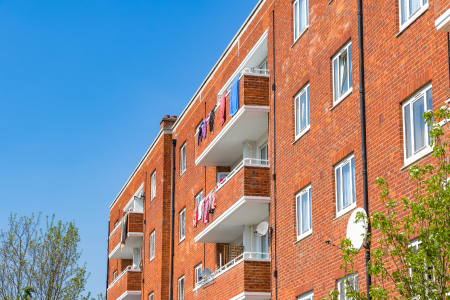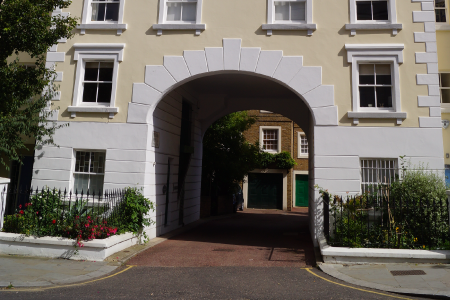What is a Flying Freehold?
A flying freehold is a common legal concept, unique to the UK, that occurs when part of a building or property extends over an adjoining property without the necessary rights or permissions.
This can happen due to various architectural features, such as when a roof overhangs a bordering property, or when a chimney, balcony, or terrace extends out over another building.
We'll delve into the complexities of flying freeholds, common examples, and potential legal challenges. We'll also discuss strategies for resolving disputes, the impact of planning permissions, and a real-world case study.
- Disputes can arise over rights and responsibilities which affect both properties (for example, the maintenance of overhanging structures), which can be complex. Resolution may require negotiation, mediation, arbitration, or in extreme cases, litigation.
- Flying freeholds can deter lenders, who each have specific requirements for properties with flying freeholds, and you will likely need to take out indemnity insurance or agree to higher interest rates.
Is a flying freehold a leasehold?
No, a flying freehold is not a leasehold. While both involve ownership interests in property, a leasehold is a temporary right to use property that belongs to another person, while a flying freehold is a permanent ownership interest that extends over another property.
Examples of flying freehold
Roof overhangs
A common example is when the eaves of a roof extend over a bordering property. This can cause issues with rainwater runoff and potential damage such as damp and timber decay.
Roof overhangs also provide shelter for pests, such as birds, insects, or rodents and this can lead to a pest infestation in both properties or more if the roof extends over multiple homes.
Balconies and terraces
Balconies or terraces that hang over a next-door property can create privacy concerns and potential safety hazards.
An overhanging balcony could block sunlight from reaching a neighbour's property, affecting their enjoyment of a garden or outdoor space.
Rainwater can accumulate on overhanging structures and potentially leak onto the neighbouring property, causing water damage and damp issues.
Legal action can also be taken if the balcony or terrace is causing excessive noise or disturbance.
Chimneys
Chimneys that extend or lean over another property can pose risks of fire or structural damage.
A leaning chimney's structural instability also poses health risks to the occupants directly below if it collapses, causing damage to not only the property but endangering the people living inside too.



Windows
In some cases, windows that protrude over a neighbouring property can be flying freeholds, especially if they infringe on the other property's privacy or light.
The window might offer a direct view into a neighbour's property, compromising their privacy, or it might add more weight to the boundary wall, potentially causing structural damage.
If the overhanging window was installed without proper legal authorisation, it could be considered a trespass and disputes can arise with neighbours over boundaries.
It's best to seek legal advice here, but you might be able to negotiate or compromise with the neighbour.
Multi-storey buildings
In a building where walls are shared between multiple units or flats, it can be difficult to divide vertically and evenly. This could result in party wall disputes and confusion over who is responsible for maintenance.
Consider getting a party wall agreement to outline the rights and responsibilities of each property owner.
Basements or cellars
A property will be considered a flying freehold if there is a basement or cellar that stretches underneath a neighbouring home.
If the basement or cellar is not adequately supported or maintained, it could lead to subsidence of the neighbouring property, causing cracks in walls and floors.
Access could also be an issue if a basement requires access through a neighbour's property or land, leading to disagreements over rights of way and maintenance responsibilities.
The impact of industrialisation
The Industrial Revolution brought changes in land use and urban development in the UK. As cities expanded rapidly, new buildings were constructed close to each other, increasing the likelihood of flying freehold properties. The need for efficient use of space often resulted in architectural designs that intruded upon neighbouring properties.

- Expert panel of conveyancing solicitors, with local knowledge.
- Your transaction is protected by our No Sale, No Fee policy. Terms apply.
- Fixed fee conveyancing.
- We are on 99% of mortgage lender panels.
- We can solve any property challenge.
Should I buy a house with a flying freehold?
While flying freeholds can raise concerns, there's no reason to avoid purchasing a property with one. However, it's important to consider the potential legal and financial implications.
These concerns apply to existing homeowners of flying freehold and those looking to purchase a property overhung by a flying freehold.
Legal risks
Disputes can arise between neighbours over the rights and responsibilities associated with the properties.
For example, if a basement extends below a neighbouring property, disputes can arise around the boundaries of each property and who is responsible for structures on the border of these boundaries.
Maintenance costs
Maintaining a flying freehold often requires collaboration with neighbours, increasing the costs and potential for disagreements. You also need to determine who is responsible for the maintenance and costs.
If an overhanging structure adds too much weight to a boundary wall and collapses, you will need to decide who is responsible for rectifying the structural damage and the subsequent maintenance costs after the work has been done to fix the damage.
Property value
In some cases, a flying freehold can negatively impact the property's value, especially if there are unresolved legal issues or maintenance concerns.
For example, a home that relies on the property next door for structural support (like houses lined up on a steep hill) might be valued differently from a standard property.
A property with an ongoing dispute with a neighbour over privacy concerns caused by an overhanging window might deter buyers and bring the market value down.
As a prospective buyer, your lender might withdraw or reduce their mortgage offer if the property is undervalued due to a flying freehold. Even if you buy with cash, you may not get your money back on resale if the property is undervalued.
Determining liability for flying freehold issues
An example of a leaning or extending chimney
Conveyancing solicitors often approach flying freeholds cautiously. While the majority of these homeowners experience no issues, the legal complexities can raise concerns.
In the UK, the rules surrounding liability for damage caused by a neighbour's flying freehold property or structure can vary depending on the circumstances.
Negligence - if the neighbour was negligent in maintaining a leaning or extending chimney, they might be liable for the damages. Negligence could be: failing to conduct regular inspections, ignoring signs of deterioration, or failing to make necessary repairs.
Nuisance - if the overhanging chimney was a nuisance, the neighbour may be liable for the damages. A nuisance in UK law is something that interferes with a person's enjoyment of their property.
Easements - there might be an easement related to the chimney, and that could outline the responsibilities of each property owner.
Rylands v. Fletcher rule - in some cases, the Rylands v. Fletcher rule might apply. This rule states that a person who brings or keeps something on their land that is likely to do mischief if it escapes is liable for any damage that results from its escape. In this case, the 'something' on their land is the chimney.
Solicitors often cite the risk of disagreements over renovation work as a potential problem. Refusal of access, disputes over costs, and protests are concerns that can arise and make solicitors hesitant to sign off on these properties
However, while these concerns are valid from a legal perspective, the reality is that most people are motivated to maintain their property in good condition, both for their benefit and to protect their investment. This self-interest often outweighs any concerns about covenants or potential disputes.
How to get a flying freehold mortgage
Buying a property with a flying freehold can complicate getting a mortgage. While some lenders have strict policies against them, others evaluate these properties individually.
To secure a loan, you'll need to prove that the property has the necessary rights for support, access, and repairs, as well as a system of enforceable rules. Lenders might also charge you a higher interest rate due to the increased risk associated with flying freehold.
You should be transparent with mortgage lenders about your flying freehold purchase and cooperate with their documentation requests.
The lender's perspective
Barclays Bank UK PLC - will lend if the flying freehold makes up less than 15% of the overall property, subject to confirmation that there is adequate structural support and enforceable repairing covenants.
Co-Operative Bank PLC - will lend if the extent of the flying freehold affects no more than 15% of the property.
Halifax - will lend if only part of the title is a flying or creeping freehold.
HSBC UK Bank PLC - will lend if there are rights for structural support protection, repair, and maintenance, and enforceable covenants.
Lloyds Bank PLC - will lend if only part of the title is a flying or creeping freehold.
National Westminster Bank PLC (NatWest) - will lend if positive covenants can be enforced. Maximum LtV ratio restricted to 90%.
Nationwide Building Society - will lend if only part of the property is affected, but won't lend if the whole property is affected.
Santander UK PLC - will lend, but will not accept indemnity insurance under some circumstances.
What is flying freehold indemnity insurance?
Flying freehold indemnity insurance is a type of insurance policy that can protect homeowners from potential legal disputes or financial losses arising from their property's flying freehold. This insurance can cover legal fees, compensation claims, or other expenses related to issues associated with the flying freehold.
Your SAM Conveyancing solicitor can arrange indemnity insurance and will provide comprehensive legal advice on the risks.
Resolving disputes involving flying freeholds
Negotiation
The most desirable outcome in a flying freehold dispute is often a negotiated settlement between the parties involved. Through negotiation, neighbours can seek to reach an agreement that addresses their concerns and avoids costly legal proceedings.
Mediation
Mediation is a facilitated process where a neutral third party helps the parties involved in a dispute to reach a mutually agreeable solution. A mediator can assist in improving communication, identifying common ground, and exploring potential compromises.
Arbitration
If negotiation and mediation fail to resolve a dispute, arbitration can be considered. In arbitration, a neutral third party, known as an arbitrator, hears evidence and makes a binding decision. Arbitration can be a more formal process than mediation but is generally less costly and time-consuming than litigation.
Litigation
As a last resort, legal proceedings may be necessary to resolve a flying freehold dispute. Litigation involves bringing a court case to determine the rights and obligations of the parties involved. This can be a lengthy and expensive process, and the outcome can be uncertain.
Alternative options for handling flying freehold issues
- Title Indemnity Insurance - covers the loss of value if there was damage due to lack of repair of the next-door property. It does not resolve the issue of the flying freehold's condition, and structural changes can void the insurance.
- Deed of Covenant - offers more control and flexibility, but requires agreement from both owners and can be costly and time-consuming. Not suitable if one party is uncooperative.
- Leasehold Conversion - this option creates a single freehold with a long lease granted to the adjoining owner, offering clear rights and obligations for both parties and does not affect ownership.
Book a FREE 15-minute meeting* with a specialist property dispute solicitor/consultant.
They'll listen to your issue and suggest ways forward, including the costs, with no obligation to use our services after the free meeting.
- What are my responsibilities?
- Who pays if a boundary wall is damaged?
- Mediation and Settlement Agreements
- Applications to court, including Declaratory Orders, Regulatory Orders, Occupational Rent
Flying freeholds and planning permissions
Planning permissions are granted by local authorities to regulate the development and use of land. These permissions can have a significant impact on the creation or existence of flying freeholds.
New developments
When planning permission is granted for a new development, the local authority will consider whether the construction will infringe the rights of neighbouring properties. If a flying freehold is likely to arise, conditions may be imposed on the planning permission to mitigate potential problems.
Existing flying freeholds
If a flying freehold already exists, changes to planning regulations or new developments in the area may raise concerns about its continued legality or impact on neighbouring properties. Homeowners may need to seek clarification or adjustments to their existing rights.
Case study of a flying freehold dispute
The "Leaning Tower of Chelsea" is a famous example of a flying freehold dispute that caught the public's attention in the early 2000s. The case involved a residential property in the affluent Chelsea neighbourhood of London that was gradually tilting towards a neighbouring building.
The dispute
The property in question, a four-story townhouse, began to lean in 2002. The cause of the lean was traced to subsidence, likely due to underground water pipes or construction work in the area. As the building tilted, it encroached upon the property next door, creating a significant safety hazard and causing concern among residents.
The legal battle
The owners of the leaning property were forced to vacate their home while engineers assessed the structural integrity of the building and developed a plan to stabilise it. The costs of these investigations and repairs were substantial, running into hundreds of thousands of pounds.
Legal proceedings followed between the owners and their neighbours, with both parties claiming damages and seeking compensation. The case involved legal arguments and expert testimony from structural engineers, geotechnical experts, and legal professionals.
The resolution
Eventually, a settlement was reached between the parties involved. The terms included a substantial payment to the neighbouring property owners to compensate for the damage caused by the leaning building. The owners of the leaning property were also responsible for the costs of stabilising the building and ensuring its safety.
The "Leaning Tower of Chelsea" is a cautionary tale about the potential consequences of flying freeholds. It highlights the importance of early detection and intervention when structural problems arise. In cases where a building is leaning or encroaching upon neighbouring property, prompt action is essential to prevent further damage and mitigate legal disputes.
SAM can help with your flying freehold purchase
SAM's experienced flying freehold solicitors will advise you on any risks. You'll have one point of contact who will track your progress within the conveyancing process. They will make sure everything is up to speed during your homebuying journey.
Jack is our resident Content Writer with a wealth of experience in Marketing, Content, and Film. If you need anything written or proof-read at a rapid speed and high quality, he's your guy.
Caragh is an excellent writer and copy editor of books, news articles and editorials. She has written extensively for SAM for a variety of conveyancing, survey, property law and mortgage-related articles.















